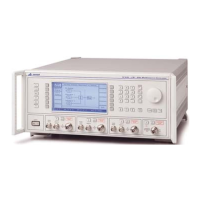46882/439 6-1
Chapter 6
BRIEF TECHNICAL DESCRIPTION
Introduction
The 2026 is a multiple source generator which consists of two (or optionally, three) signal sources
in one instrument. Each source is a fully functional RF signal generator with AM, FM, ΦM and
pulse modulation capability. The 2026 covers the frequency range of 10 kHz to 2.4 GHz. Output
levels range from −137 dBm to +24 dBm. A block schematic for the instrument is shown in
Fig. 6-1.
The block diagram shows the internal circuits of one of the sources, the C source, in detail. The A
and B sources have the same configuration. Data from the AUXILIARY PORT and the
instrument frequency standard are fed to all sources. RF output from each source is switched
either directly to its individual RF OUTPUT socket or to the combiner then out to the
COMBINED RF OUTPUT connector. In the case of an instrument fitted with a third source, the
C source output to the combiner is via an external link connected between the INT O/P and the
EXT I/P sockets.
Modulation
The carrier frequency of each signal source can be frequency, phase or amplitude modulated from
internal or external modulation sources. The internal modulation source can be the sum of two
signals and used in combination with an external modulation source connected to the front-panel
EXT MOD INPUT connector. In addition to analogue FM, 2-level and 4-level FSK signals are
generated from external logic inputs to the AUXILIARY PORT connector.
Frequency generation
A voltage controlled oscillator (VCO) in each signal source covering the frequency range 400 to
533 MHz is phase locked to a 10 MHz temperature-compensated crystal oscillator using a
fractional-N synthesizer system. Additional frequency coverage is achieved by means of
frequency division or multiplication. Low frequencies are generated by a beat frequency oscillator
(BFO) system.
Display
The display is a high-definition dot-matrix liquid crystal panel with backlighting to cater for
variations in ambient light conditions. The display contrast can be adjusted.
Control
The 2026 is a menu-driven instrument. Main menus are displayed by the use of hard keys, and
parameters are changed by means of soft keys which change as the menu changes. Internal
control of the instrument is achieved by a microprocessor which receives data from the various
controls and sends instructions via an internal 8-bit data bus to the signal processing circuits.
The instrument can also be controlled by either the built-in General Purpose Interface Bus (GPIB)
or the RS-232 interface. The interfaces enable the instrument to be used both as a
manually-operated bench-mounted instrument and as part of a fully automated test system. The
RS-232 interface can also be used to reprogram the internal flash memory.

